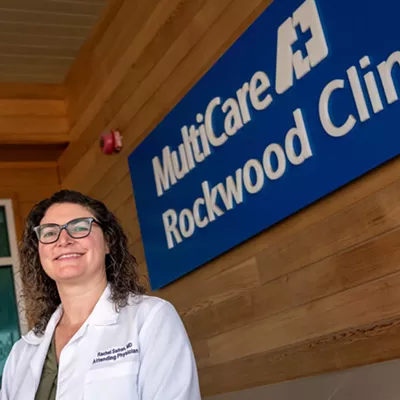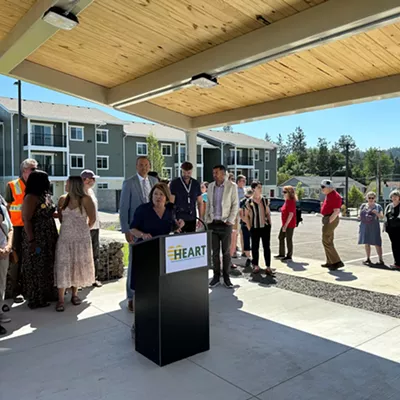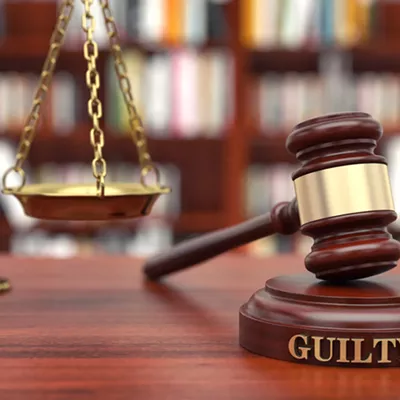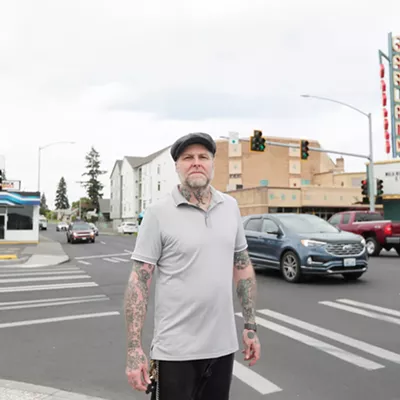What, you haven't seen the yard signs? Or the TV ads? What about all the mud-slinging debates and fiery arguments? Yeah, neither did we.
The two propositions concern the future of light rail in Spokane County. They ask voters whether the transit authority should continue down the track (ahem) it's been on for the last couple decades and whether it should keep pursuing the idea of a commuter train. Neither proposition is asking for money. They are simple advisory votes, meant to poll the public on their willingness to consider making a decision on the issue -- and pay for it -- somewhere down the line. In that sense, the questions sound insignificant.
They're not. These may simply be advisory votes, but many who have been working on the light rail project for years say this is a decisive moment. A resounding "no" on both propositions could shelve light rail for years, or -- some say -- kill it forever. A hearty yes could put the project into overdrive, leading to a final vote as soon as 2008.
But you wouldn't know this judging by the underwhelming media campaign, which got a late start and, with only a few bucks to its name, is finding it difficult to get the word out. Nor might you understand it clearly looking at your ballot, which, confusingly, asks you two separate, somewhat complicated questions.
Ah, democracy.
& lt;span class= "dropcap " & P & lt;/span & roject proponents want to build a light rail system that stretches 15.5 miles from downtown Spokane's transit center through Spokane Valley to Liberty Lake, according to a lengthy recommendation submitted in June to Spokane Transit Authority's board of directors by the Light Rail Steering Committee (a panel made up of citizens, elected officials and state employees).
The trains -- initially single-car, diesel-powered vehicles -- would run on a single set of tracks and stop at 14 stations -- at the Spokane Convention Center and University District, at the Fair & amp; Expo Center ("the fairgrounds"), and at several places in Spokane Valley (at Argonne, University City, Pines, Evergreen and Sullivan). They'd connect to pre-existing bus lines and would arrive every 15 minutes during peak hours (most of the day, Monday through Saturday), every 30 minutes during off-peak hours. The last train would depart around 11 o'clock at night.
The system would cost $263 million in today's dollars, though it's too early to tell how much of this would be shouldered by local taxpayers and how much would be funded by other sources. Unlike Portland's popular (and growing) MAX system, little of the necessary money for Spokane light rail would come from the federal government. Still, nobody's even ball-parking actual costs yet.
Meanwhile, light rail enthusiasts like to point out what the system could end up paying us. A report drafted last summer by a pair of economic think tanks in Portland and Phoenix reckoned that building the fixed light rail system would grow jobs, spur development and jack up the assessed value of homes in the area around the tracks. Almost 12,000 housing units would crop up around the system. The surrounding development would, by 2025, sign $561 million worth of paychecks for local workers each year.
That effect, the report speculates, would never happen with a regular bus system, or even a bus rapid transit system, as it suggests the fixed nature of light rail tends to grow developments around it in a way that impermanent bus lines do not.
"While Bus Rapid Transit can be as effective in relieving congestion as light rail, there is little evidence that it supports or stimulates the same level of transit-oriented development," the report says.
Thus, rail supporters see a future where commuters step out their front doors, grab a cup of coffee near the bustling station and hop on a train to get to work in the morning. Where they ditch their cars in parking lots in the 'burbs and trundle into a tightly packed urban center. Where quiet, clean, quick trains replace traffic gridlock, and where you have a moment to read the paper before you get to work and everyone's friendly and neighbors who have never met out on the interstate see each other across the crowded car and shoot rainbows from their hearts, and...
& lt;span class= "dropcap " & O & lt;/span & K, so we're getting ahead of ourselves. The aforementioned recommendation made by the Light Rail Steering Committee is very thorough. They know exactly where they want to put stations, how many trains the system would need, how long those trains should be, where they would have their own tracks and where they'd share with existing Union Pacific and Burlington Northern tracks.
They've also built their proposal in such a way that it's scalable. Single-unit diesel-powered cars could, in time, be replaced by multiple-unit electric ones. The east-west line could eventually link to a line that serves the north part of Spokane.
But those are all concerns for the future. Before they can ask voters for the green light to start building -- before they can even tell voters how much it will cost them -- they want to know if the public is even interested.
That's where the November ballot comes in. In case you're keeping score at home, here's the text of Proposition 2, the second question on the ballot (you'll understand the flip-flop momentarily):
& lt;span class= "dropcap " & S & lt;/span & hould Spokane Transit Authority use existing resources to fund preliminary engineering/design and environmental analysis for a future light rail system to run from Spokane City, through the City of Spokane Valley, to the City of Liberty Lake?
The Light Rail Steering Committee and other groups that have been involved with the project so far have, as previously mentioned, already put together a fairly thorough plan for what a light rail system would look like in the Spokane area. They've also completed a preliminary environmental impact statement. But that's where the planning has stopped. The next step toward figuring out how feasible the project is -- and bringing the issue to a point where voters can make the final decision -- is to start doing some legwork. More environmental analyses need to be performed, and engineers need to start tinkering. That's what this question is about. Should the STA take the next step in figuring out if this will work?
More specifically, a "yes" vote on this question would give the STA the thumbs-up in terms of procuring the rights-of-way needed to make the train system happen.
Liberty Lake City Councilman Brian Sayrs is the head of STA's board of directors. He says that the light rail project is fortunate in that much of the right-of-way needed to move the train from point A to point B is already in public ownership, or could be shared with pre-existing lines, like the Union Pacific's. But other sections would need to be purchased to move the trains through. Of particular interest is a portion on the eastern edge of Spokane Valley's Sprague/Appleway couplet, which was set aside for high-capacity transit by county commissioners in the 1990s, but which is hot property as Spokane Valley considers whether or not it wants to extend the couplet.
Sayrs hopes voters will advise the board to start scooping up parcels like this one. "Whether this generation builds light rail, or a later generation does," he says, "securing the right of way eliminates the biggest risk to the project -- that is, finding a place to put it."
The "existing resources" alluded to in the ballot question, Sayrs says, are funds that STA has sitting in its reserve -- the product of "an odd increase" in the amount of sales tax revenue in Spokane in the last year. He says the STA is looking at the unexpected influx as "one-time revenues." In other words, they're not going to use the money to bump up the overall level of bus service, because there's no indication that they'll get a similar amount next year to sustain increased service levels. So they're looking to spend that money on one-time projects -- like right-of-way acquisition.
"Either way, no matter how you vote on these two issues, the tax rate isn't going to change and bus service isn't going to change," he says.
Still, it's a tender subject. The state legislature's 1999 decision to price license plate tabs at a flat $30 took a chunk out of the budgets of transit organizations across the state. When Spokane Transit went to the voters in 2002, asking them to help keep current bus service levels the same by making up with their pocketbooks what Olympia took away, the vote went down 48 percent to 52 percent. When they asked again in 2004, voters gave it 69 percent approval, but only after a lengthy public discussion about where that money would go -- would this restore bus service levels, or would STA use it to fund light rail?
"The commitment that several of the individual board members made -- and there's only two of us left," says Sayrs, was this: "'Listen, we weren't talking about light rail. And, in fact, it's not our intent to add new revenues to the light rail project without a vote of the people.'" He adds that "Spokane Transit legally has the authority to do these things, but we're polling the public to find out what their intent is. I've been casting these not as legal questions -- not as gaining the legal authority -- but as gaining the moral authority to continue. And I say that personally as a light rail supporter."
The issue is especially hot when considering that the increase approved by voters in 2004 runs out after 2008, when it'll be brought back to the ballot for re-approval.
Which brings us to the first question on the ballot -- Proposition 1 -- which reflects a more short-term focus. Here's its text:
& lt;span class= "dropcap " & S & lt;/span & hould Spokane Transit Authority identify regional funding sources and local taxing alternatives and develop a funding plan to build a $263,000,000 rail project, in 2006 dollars, to run from Spokane City, through the City of Spokane Valley to the City of Liberty Lake, and bring that funding plan to the voters at a future election?
& lt;span class= "dropcap " & I & lt;/span & n other words, the STA doesn't have a clue what this is going to cost you, but can it find out and get back to you?
The question also serves as a reminder that the STA's not asking for more money, and that it won't make such a request until after the 2008 re-up vote. "We're not going to propose creating a light rail system until the bus system can fund itself," says Sayrs.
Still, Proposition 1 has been a matter of debate for months. The original idea was to ask only the second question -- about using the money sitting around to start picking up right-of-ways and figuring out the nuts and bolts of the system -- and to bring a financing plan to voters when they had the financial details to present.
"The Steering Committee only forwarded the one question: 'Please advise the board to use existing funds...,'" says committee chair Phyllis Holmes. "The steering committee in no way, shape or form -- in no way, shape or form -- forwarded that other question. That is a product of the board itself."
Holmes calls that first question "premature," and says that the details of funding are far too uncertain to ask voters to opine now. She points to the recent overtures by state Sen. Lisa Brown to get state funding for the project as proof that the details of who will pay what are still highly liquid. The potential for state money, she says, "changes everything.
"From my perspective," Holmes adds, "it's a premature question. Having that question that is ahead of its time may well add an element of confusion. The other question is pretty straightforward and clear and is the right question to be asking. I think there are members of the board who are reluctant to take a stand at this point in time."
It was Spokane City Councilman Al French and Spokane Valley Councilman Rich Munson who fought hardest to add the first question.
French says he sees it as a political courtesy. "We really are trying to be as diligent as possible with regard to not spending any STA money to further this initiative unless the voters want us to." But he also thinks the two questions send the board two differing -- and necessary -- messages: "'We want to move forward with light rail today' -- that sends us down one track," he says. "Or, 'We really like the idea of light rail, but we're not ready for it today, but we don't want it to die.' That's why we have two questions on there."
& lt;span class= "dropcap " & F & lt;/span & rench acknowledges the risk that putting two separate questions on the ballot might confuse voters, resulting in a knee-jerk double-no vote (look at last year's two statewide medical malpractice initiatives), but he notes, "We thought that the risk of not getting the information we wanted was greater than the risk of the possibility that somebody might be confused."
Whatever the case, arguments about whether to add the first question to the ballot (and how to word it) weren't resolved, despite a special meeting in August, until the STA board's Sept. 21 meeting -- the day before propositions needed to be filed with the county auditor.
That's left very little time for a public campaign to spread the word about the measure, which has resulted in fairly low exposure. Campaign organizers say they've only put up around 150 yard signs. The head of the campaign, Michele Maher, a former member of the state transportation commission, says they've placed ads in The Inlander and the Spokesman-Review, but that they can't afford a TV spot, other than maybe a free ad from Comcast. According to the state's Public Disclosure Commission, the campaign's political action committee -- Citizens Looking Forward -- has only raised $1,100 so far.
But Maher, strangely, sounds unworried. She points out that there is no "No on Light Rail" committee and that all the calls her campaign has fielded have been from people eager to help -- so obviously, people are aware that the crucial vote is coming up. She argues that although her campaign wasn't able to get started officially until the board made its September decision, in reality the entire 10- to 20-year thrust to get light rail in Spokane has been one long campaign preparing voters for this moment.
"I'd like to believe we've been campaigning all along," she says.
And Maher sounds confident. She and others point to a recent poll indicating that as many as 48 percent of respondents liked the idea of light rail (28 percent were opposed). Of course, in that same study 53 percent suggested they didn't want to pay for it. But proponents are hoping that, faced with two questions that cost them noting, voters will at least keep the issue alive.
& lt;span class= "dropcap " & S & lt;/span & teering committee chair Phyllis Holmes says if voters don't approve the propositions, the prospect of light rail is kaput.
"Oh, it's over," she says. "Spokane won't have light rail." She says a "no" vote will send a clear message to the STA board that the public isn't interested in light rail, and that that precedent could make it impossible to revive the issue down the line. "If the community is not willing to do it now, when on earth would it be?" she asks.
Holmes says that Spokane's light rail project has a unique window of opportunity, noting that it's "one of the lowest-priced projects in the United States right now" and that the longer the community waits to get moving, the more expensive the project will become and the more likely that crucial rights-of-way will be snapped up for other developments.
Holmes urges a pro-active approach: "Do you wait until the horse is gone to close the barn door? We're trying to anticipate the horse leaving the barn so we can get that barn door secured."
French agrees about rising costs. "I can't speak to whether it's dead forever. I guess I've never bought into that kind of thinking," he says. "[But] I clearly think it's going to get more expensive with time. Nothing is getting cheaper these days."
Brad Stark, on the other hand, stresses that this is merely an advisory vote. The Spokane city councilman, who sits on STA's board of directors, says it ain't over until the board loses its resolve.
"It's gonna come down to an exercise in leadership and such with the STA board," he says. "Personally, even if none of the measures pass, I still want to do the property acquisitions. [We've] been dealing with this for 10 years now. Even if it doesn't pass, I want to move forward."
Despite the confusing double-question set-up on the ballot, and despite the tiny window given to Citizens Looking Forward to get the word out about the light rail propositions, the choice on this ballot is clear. Unlike last year's dueling medical malpractice initiatives, says Brian Sayrs, the two light rail questions go hand in hand.
"The questions are posed as they ought to be," he says. "You vote yes if you like light rail, and you vote no if you do not."
WHO KILLED THE ELECTRIC TRAIN?
& lt;span class= "dropcap " & I & lt;/span & n 1910, three times as many riders utilized Spokane's electric trolley system than use Spokane Transit's bus system today, according to the Spokane Regional Light Rail Project. And this was despite a population that was less than half the size Spokane is today.
The first line was built in the late 19th century by investors hoping to link the new Browne's Addition neighborhood to downtown. By 1923, Spokane was covered in the spaghetti of light rail tracks. A map from that time shows 19 separate lines reaching as far north as Francis and as far south as 37th, touching Finch Arboretum in the west and Havana Street on the eastern edge of town.
Today, Spokane's trying to get just one of those lines back.
In March, the Downtown Spokane Partnership revealed a streetcar feasibility study that, while a little short on details, suggests alignments for a streetcar system that could run from Kendall Yards and county government buildings north of the river through downtown to the University District. That segment would cost roughly $50 million dollars. The study also suggests additional routes that could be added later -- including tracks that would reach Browne's Addition and the Hospital District.
Of course, this has nothing to do with the light rail propositions currently on the ballot, in terms of funding or planning. But the two designs, proponents say, would be perfectly simpatico.
"The light rail system would bring people downtown," Spokane Regional Light Rail Program Manager K.C. Traver told the Spokesman-Review in April. "The streetcar system circulates those people."
Sound familiar?
"We should have probably left the tracks in to begin with," says Spokane city council member Al French, speaking of those 100-year-old trolleys. "We've come full circle."
-- JOEL SMITH














